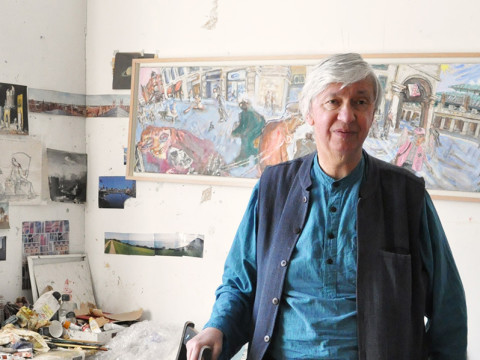
In memoriam: Richard Rogers RA
By Norman Foster RA
Published on 3 May 2022
Norman Foster RA remembers his friend, fellow student, Team 4 partner and pioneer of inside-out buildings.
I am so deeply saddened by the loss of my oldest and closest friend, Richard Rogers. Over the time since we met, almost exactly 60 years ago as students at Yale University, Richard has been a kindred spirit.
In a first of its kind, we collaborated on projects in the Yale Masters class and, in every break, we travelled together across the United States to be inspired by the works of past and modern masters. Our rapport on everything architectural amounted to a privately shared language that could encompass both criticism and appreciation.
With the briefest of breaks, we continued our unique blend of friendship and collaboration into private practice with two architect sisters as Team 4, before eventually going our own ways as separate practices in 1967. Since then, we have come full circle to be closer than ever as families.
If a tribute is about a life and not a departure, because Richard’s legacy will live on, then how do I start to define the life and work of my dear departed friend? Do I start with the person and move onto the architecture or vice versa? Either way will work because the one is a manifestation of the other.
Richard was gregarious, outgoing, generous and possessed an infectious zest for life. His buildings are a social mirror of that personality – open, welcoming and, like his wardrobe, elegantly colourful. The Rogers signature is an architecture that makes manifest and celebrates the role of the structure. Technology comes to mind in my reference to his architecture, but it is always as a means to the social agenda.
A video introduction to the exhibition ‘Richard Rogers RA: Inside Out ’ at the Royal Academy of Arts in 2013.
Perhaps the one building that is the epitome of combining expressive structure and the social agenda is the Pompidou Centre (1977), co-authored with Renzo Piano Hon RA – the ultimate venue in a striving for universal access to culture. Architecturally one would have to add the accompanying bravura of expressed ductwork and mechanical plant – the so-called ‘services’ that normally lay buried as innards within a building. The Lloyds building (1986) in the City of London continues that tradition of a sculptural display of external pipework and circulation, but here a unifying metallic sheen takes over from the exuberant Pop Art colours of Pompidou’s elevations.
For me there is a resonance between some later works and his earlier designs, where expression of structure and colour, solely defining the form of the building, is uncompromised by the presence of services. I have in mind the early, unbuilt Zip-Up House and the Wimbledon home for his parents at 22 Parkside (1968–69). In their formal simplicity they have affinities with works such as his terminal for Madrid’s Barajas Airport (2005). These are buildings which, regardless of size, share a delicacy of scale from the big picture down to the exploration of a junction. The later trends in Richard’s work were anticipated in the Royal Academy exhibition 35 years ago, ‘New Architecture: Foster, Rogers, Stirling’. Richard and I had come under the influence of James (Jim) Stirling while he was a visiting critic to the Yale Masters class, so in that sense he was more a mentor than a contemporary.
Given Richard’s passion for the community spirit of a building, it is perhaps no surprise that he was a lover of cities and championed their cause as a committed urbanist. Whether as an advisor to mayors and government, or as a writer on the subject, he was a tireless supporter of the compact, sustainable, pedestrian-friendly city and a passionate opponent of mindless suburban sprawl. These convictions were embedded in our private language when we came together in our twenties and there was the same fire in his belly (a phrase he would love) up to the very end. On the subject of love, Richard’s life as an architect is inseparable from that of his family and any tribute to him is one to his wife Ruthie and their devotedly caring family.
Richard Rogers was a great pioneering architect of the modern age, socially committed and an influential protagonist for the best of city life – such a legacy. I will miss him dearly.
Norman Foster RA is an architect. This is an extended version of a text first published by his practice, Foster + Partner.
Related articles

In memoriam: Norman Ackroyd RA
20 September 2024

In memoriam: Timothy Hyman RA
12 September 2024
